13 Best Herbal Teas For Dry Throat
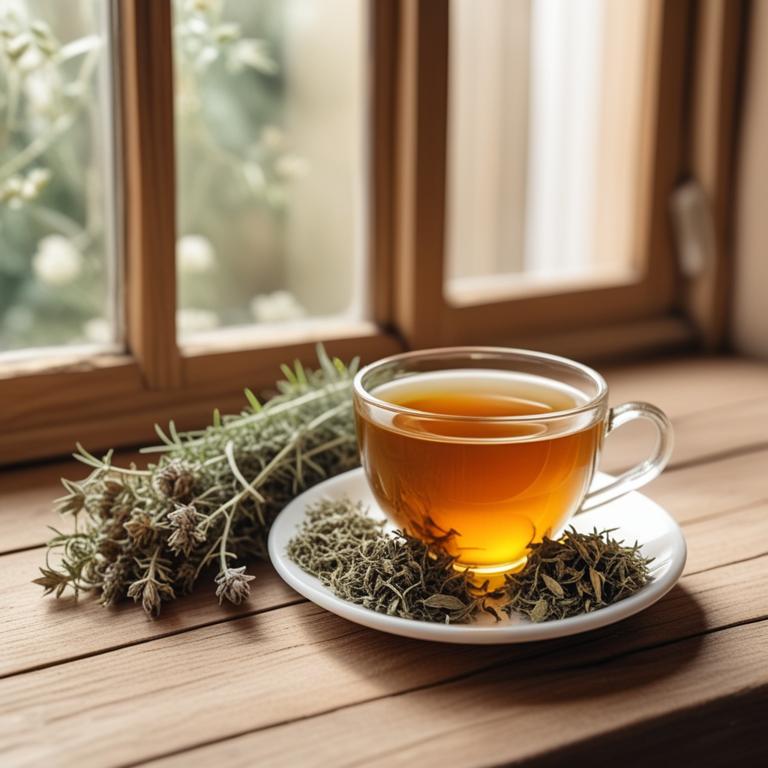
Herbal teas for dry throat are a type of medicinal tea made from various herbs, flowers, and plants that help soothe and relieve dryness, irritation, and discomfort in the throat.
These teas can effectively treat dry throat ailments due to their anti-inflammatory, antibacterial, and moisturizing properties, which help calm the throat and reduce inflammation.
Some examples of herbal teas that can be used to treat dry throat include slippery elm, which forms a protective barrier on the mucous membranes, licorice root, which has anti-inflammatory properties, and peppermint, which helps to thin mucus and provide relief.
Additionally, other herbal teas such as ginger, chamomile, and thyme can also be used to treat dry throat due to their soothing and calming effects.
Related Study
According to "Journal of alternative and complementary medicine (New York, N.Y.)", teas for dry throat such as Traditional Medicinals' Throat Coat, a traditional demulcent herbal tea, have been found to provide a rapid, temporary relief of sore throat pain in patients with pharyngitis.
Below there's a list of the 13 best herbal teas for dry throat.
Table of Contents
- 1. Glycyrrhiza glabra teas
- 2. Thymus vulgaris teas
- 3. Echinacea purpurea teas
- 4. Zingiber officinale teas
- 5. Rosmarinus officinalis teas
- 6. Lavandula angustifolia teas
- 7. Eucalyptus globulus teas
- 8. Sambucus nigra teas
- 9. Mentha x piperita teas
- 10. Melissa officinalis teas
- 11. Hydrastis canadensis teas
- 12. Salvia officinalis teas
- 13. Achillea millefolium teas
Also, you may be interested in...
Today Free Bonus!
The Ultimate Herb Drying Checklist
(For Long-Lasting Powerful Medicinal Effect)
How to easily dry herbs that don't mold and that keep their strong medicinal power for more than 1 year.
1. Glycyrrhiza glabra teas

Glycyrrhiza glabra teas, a traditional herbal remedy, have been used to treat dry throat ailments due to its soothing and anti-inflammatory properties.
The active compounds in Glycyrrhiza glabra, such as glycyrrhizin and flavonoids, help to reduce inflammation and relieve dryness in the throat, providing quick and effective relief.
The bioactive constituents, particularly glycyrrhizin, possess expectorant properties that help to thin mucus and promote its expulsion, further aiding in the treatment of dry throat ailments.
Regular consumption of Glycyrrhiza glabra teas has been shown to provide numerous benefits, including reduced throat irritation, improved respiratory health, and enhanced overall well-being, making it a popular natural remedy for dry throat conditions.
Related Study
According to "Journal of alternative and complementary medicine (New York, N.Y.)", Glycyrrhiza glabra teas, found in products such as Throat Coat, have been shown to provide rapid and temporary relief of sore throat pain in patients with pharyngitis.
Recipe:
- Gather 1 cup of water and 1 tablespoon of dried Glycyrrhiza glabra root.
- Bring the water to a boil in a pot, then reduce heat to medium.
- Add the dried Glycyrrhiza glabra root to the pot and let it steep for 5-7 minutes.
- Strain the tea into a cup and let it cool for a few minutes.
- Drink the tea while it's warm to soothe a dry throat.
Glycyrrhiza glabra teas can help alleviate dry throat symptoms due to their soothing and anti-inflammatory properties, but possible side effects may include headaches, dizziness, and an increase in blood pressure in some individuals.
To minimize potential risks, it is recommended to consume these teas in moderation, ideally for short periods, and to be aware of the ingredients and potential interactions with other medications, especially those that affect the heart and blood pressure.
Glycyrrhiza Glabra Tea on Amazon
Pukka Herbal Teas Licorice and Cinnamon - 20 Bags, 20 Count
Disclaimer: We earn a commission if you click this link and make a purchase at no additional cost to you.
2. Thymus vulgaris teas
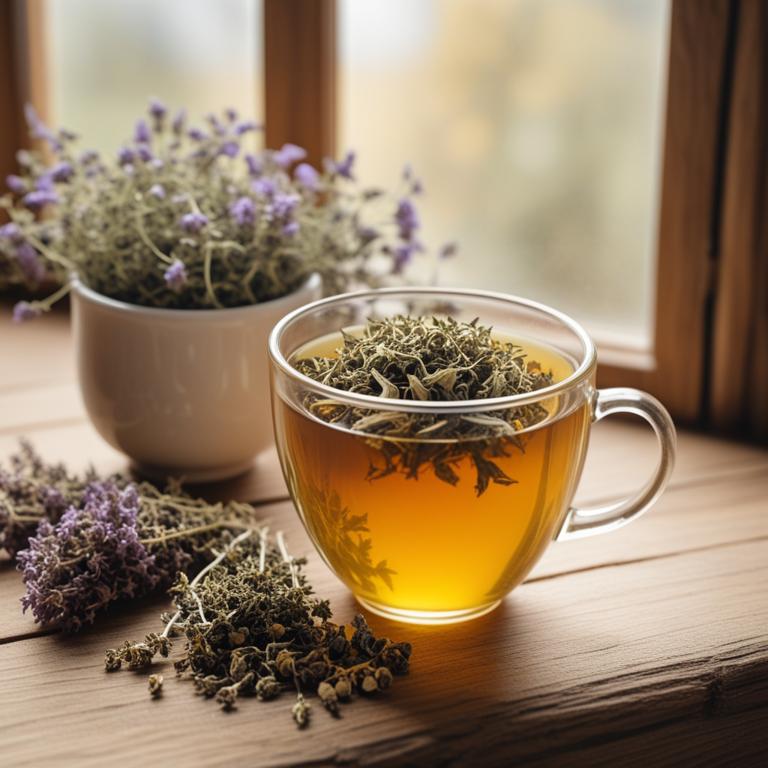
Thymus vulgaris teas, also known as thyme tea, have been traditionally used to treat dry throat ailments due to their anti-inflammatory and expectorant properties.
This herbal preparation helps to treat dry throat by soothing and calming the irritated mucous membranes, reducing inflammation and promoting the removal of excess mucus.
The bioactive constituents of thyme tea, including thymol and carvacrol, have been shown to exhibit antimicrobial and antioxidant activities that contribute to its therapeutic effects.
The benefits of using thymus vulgaris teas to treat dry throat include rapid relief from discomfort, reduced coughing, and improved overall respiratory health.
Related Study
According to "Wiadomosci lekarskie (Warsaw, Poland : 1960)", Thymus vulgaris teas for dry throat may be beneficial due to its spasmolytic, antimicrobial, anti-inflammatory, immunomodulatory, and antioxidant properties, particularly thymol, which can help alleviate cough and other symptoms associated with upper respiratory tract infections.
Recipe:
- Gather 1 cup of boiling water and 1 tablespoon of dried thyme leaves.
- Measure out 1 teaspoon of dried thyme leaves from the 1 tablespoon.
- Steep the thyme leaves in the boiling water for 5-7 minutes.
- Strain the mixture into a cup and discard the thyme leaves.
- Drink the thyme tea while it's still warm to help soothe a dry throat.
Thymus vulgaris teas can help alleviate dry throat symptoms, but possible side effects include allergic reactions, digestive issues, and interactions with certain medications, such as blood thinners and diabetes medications.
To use Thymus vulgaris teas safely, it is recommended to start with small doses, avoid consuming them on an empty stomach, and be cautious when combining them with other medications or herbal supplements to minimize potential interactions and side effects.
Thymus Vulgaris Tea on Amazon
Buddha Teas Organic Thyme Leaf Tea - OU Kosher, USDA Organic, CCOF Organic, 18 Bleach-Free Tea Bags
Disclaimer: We earn a commission if you click this link and make a purchase at no additional cost to you.
3. Echinacea purpurea teas

Echinacea purpurea teas have been traditionally used to treat dry throat ailments due to their anti-inflammatory and antioxidant properties, which help to soothe and calm the irritated mucous membranes.
The bioactive constituents of Echinacea purpurea, including alkylamides, caffeic acid derivatives, and flavonoids, work together to reduce inflammation, prevent bacterial infections, and promote tissue repair.
By consuming Echinacea purpurea teas, individuals can experience relief from dry throat symptoms, such as soreness and discomfort, and improve their overall well-being.
The benefits of using Echinacea purpurea teas to treat dry throat ailments include reduced inflammation, enhanced immune function, and a faster recovery time.
Related Study
According to "The Cochrane database of systematic reviews", Echinacea purpurea teas may provide some relief from dry throat due to some preparations being better than placebo in the treatment and prevention of upper respiratory tract infections.
Recipe:
- Gather 1 cup of fresh or dried Echinacea purpurea flowers.
- Use 1 cup of boiling water to make the tea.
- Add 1-2 tablespoons of the Echinacea flowers to the boiling water.
- Steep for 5-7 minutes, then strain the tea.
- Drink 1-2 cups of the tea throughout the day to soothe a dry throat.
Echinacea purpurea teas can be an effective treatment for dry throat, but it may cause side effects such as allergic reactions, dizziness, and stomach upset in some individuals.
When using Echinacea purpurea teas to treat dry throat, take precautions to avoid overconsumption, as excessive use can lead to increased heart rate, insomnia, and interactions with certain medications, particularly blood thinners, diabetes medications, and blood pressure medications.
Echinacea Purpurea Tea on Amazon
BLUE TEA - Chamomile Tea - Butterfly Pea Flower -18 Count - Pyramid Tea Bag | DETOX TEA | Caffeine Free - Flower Based - Vegan - Non-Bitter - Natural Ingredients | Tin Packaging
Disclaimer: We earn a commission if you click this link and make a purchase at no additional cost to you.
4. Zingiber officinale teas

Zingiber officinale teas, derived from the rhizomes of the ginger plant, have been traditionally used to treat dry throat ailments.
The anti-inflammatory and antioxidant properties of this herbal preparation help to soothe and protect the mucous membranes, reducing irritation and discomfort.
The bioactive constituents, including gingerols and shogaols, exhibit analgesic and anti-inflammatory effects, which contribute to the relief of dry throat symptoms.
Regular consumption of Zingiber officinale teas can provide relief from dry throat, promote a healthy respiratory system, and support overall well-being.
Related Study
According to "Journal of ethnopharmacology", Zingiber officinale teas for dry throat may be beneficial due to the presence of lariciresinol, a compound found in Z. officinale, which has been shown to inhibit efflux pump activity and enhance the antimicrobial potency of other compounds.
Recipe:
- Gather 1 tablespoon of dried Zingiber officinale root and 1 cup of boiling water.
- Put the Zingiber officinale root in a tea infuser or a small piece of cheesecloth.
- Steep the root in the boiling water for 5-7 minutes.
- Strain the tea into a cup and discard the root.
- Add honey to taste, if needed, and drink the tea while it's still warm.
Zingiber officinale teas can be beneficial in treating dry throat, but possible side effects include dizziness, nausea, and stomach upset due to its spicy properties and potential allergic reactions.
To minimize these side effects, it's essential to consume Zingiber officinale teas in moderation, especially for those with sensitive stomachs or allergies, and to avoid taking it on an empty stomach or before bedtime.
Zingiber Officinale Tea on Amazon
FGO Organic Ginger Tea, 100 Count, Eco-Conscious Tea Bags, Caffeine Free, Packaging May Vary (Pack of 1)
Disclaimer: We earn a commission if you click this link and make a purchase at no additional cost to you.
5. Rosmarinus officinalis teas

Rosmarinus officinalis teas, also known as rosemary tea, have been traditionally used to treat dry throat ailments due to their anti-inflammatory and soothing properties.
The herbal preparation helps to treat dry throat by reducing inflammation and irritation in the throat, providing relief from discomfort and pain.
The bioactive constituents of rosemary tea, including camphor, bornyl acetate, and ursolic acid, contribute to its therapeutic effects, with camphor acting as a natural expectorant to help loosen and clear mucus from the throat.
Regular consumption of rosemary tea has been found to provide benefits in treating dry throat, including reduced inflammation, improved respiratory function, and enhanced overall well-being.
Recipe:
- Gather 1 tablespoon of dried Rosmarinus officinalis leaves and 1 cup of boiling water.
- Heat the boiling water in a pot or kettle, then remove from heat.
- Add the dried Rosmarinus officinalis leaves to the hot water and let it steep for 5-7 minutes.
- Strain the tea into a cup using a tea strainer or a piece of cheesecloth.
- Drink the tea while it is still warm to help soothe your dry throat.
Rosmarinus officinalis teas can be an effective remedy for dry throat, but it may cause side effects such as dizziness, headaches, and stomach upset in some individuals.
To use Rosmarinus officinalis teas safely, it is recommended to start with a low dose and gradually increase as needed, and to avoid consuming it before bedtime or when driving, as it may cause drowsiness.
Rosmarinus Officinalis Tea on Amazon
Palm Beach Medicinal Herbs - Rosemary Tea - Pure Herbal Tea Series, 30ct
Disclaimer: We earn a commission if you click this link and make a purchase at no additional cost to you.
6. Lavandula angustifolia teas

Lavandula angustifolia teas are a popular herbal remedy used to treat dry throat and soothe irritated mucous membranes.
The anti-inflammatory and antimicrobial properties of this herbal preparation help to reduce swelling and combat infections that can exacerbate the condition.
The bioactive constituents of Lavandula angustifolia teas, such as linalool and linalyl acetate, have been shown to have a calming effect on the throat and promote relaxation, which can help to alleviate dry throat symptoms.
Regular consumption of Lavandula angustifolia teas can provide long-term benefits, including improved respiratory health and a reduced risk of complications associated with dry throat.
Recipe:
- Get 1 cup of boiling water and 1 tablespoon of dried Lavandula angustifolia.
- Steep the dried herbs in the boiling water for 5-7 minutes.
- Strain the mixture through a fine-mesh sieve or cheesecloth into a cup.
- Add honey to taste, if needed, to help soothe a dry throat.
- Drink the tea while it's still warm, and repeat as needed to help ease a dry throat.
Lavandula angustifolia teas can help to soothe a dry throat, but possible side effects may include drowsiness, headaches, and digestive issues due to its calming properties and potential interaction with other medications.
To minimize these side effects, it is recommended to consume Lavandula angustifolia teas in moderation, ideally 1-2 cups per day, and avoid taking it before driving or operating heavy machinery.
Lavandula Angustifolia Tea on Amazon
Tiesta Tea - Lavender Chamomile Herbal Tea | Loose Leaf | Calming Blend with Chamomile and Lavender | Caffeine-Free Herbal | Great for Hot or Iced Brews | Resealable Bulk Pouch, 200 Cups | 8 Ounce
Disclaimer: We earn a commission if you click this link and make a purchase at no additional cost to you.
7. Eucalyptus globulus teas
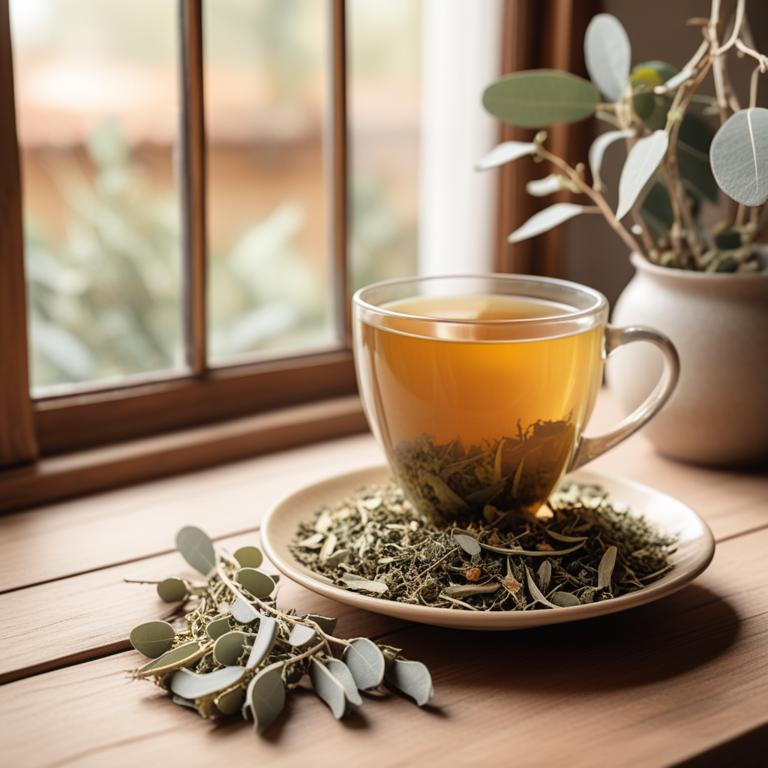
Eucalyptus globulus teas have been traditionally used to treat dry throat ailments due to their decongestant, anti-inflammatory, and antibacterial properties.
The herbal preparation helps to treat dry throat by reducing inflammation and congestion, providing relief from irritation and discomfort.
The bioactive constituents, including eucalyptol, limonene, and alpha-pinene, help to thin mucus and reduce the production of phlegm, making it easier to expel.
Regular consumption of Eucalyptus globulus teas has been shown to provide relief from dry throat symptoms, promote a healthy respiratory system, and support overall well-being.
Related Study
According to "Evidence-based complementary and alternative medicine : eCAM", Eucalyptus globulus teas for dry throat may be beneficial as Eucalyptus globulus was one of the top-cited plant species used in the treatment of respiratory disorders in Ethiopia, particularly due to its potential antimicrobial properties.
Recipe:
- Gather 1 cup of fresh eucalyptus leaves (Eucalyptus globulus).
- Add 1 cup of boiling water to a heat-resistant container.
- Add 2 tablespoons of fresh eucalyptus leaves to the boiling water.
- Steep the mixture for 5-7 minutes, then strain it.
- Drink the tea hot or warm to soothe your dry throat.
Eucalyptus globulus teas can provide relief from dry throat ailments, but they may also cause side effects such as stomach upset, nausea, and allergic reactions in some individuals.
To minimize potential risks, it is recommended to use Eucalyptus globulus teas in moderation, avoid taking them before bedtime, and monitor your body's reaction closely, especially if you have pre-existing conditions or take medications regularly.
Eucalyptus Globulus Tea on Amazon
Jovvily Eucalyptus Leaves - 1lb - Dried - Cut & Sifted - Herbal Tea
Disclaimer: We earn a commission if you click this link and make a purchase at no additional cost to you.
8. Sambucus nigra teas
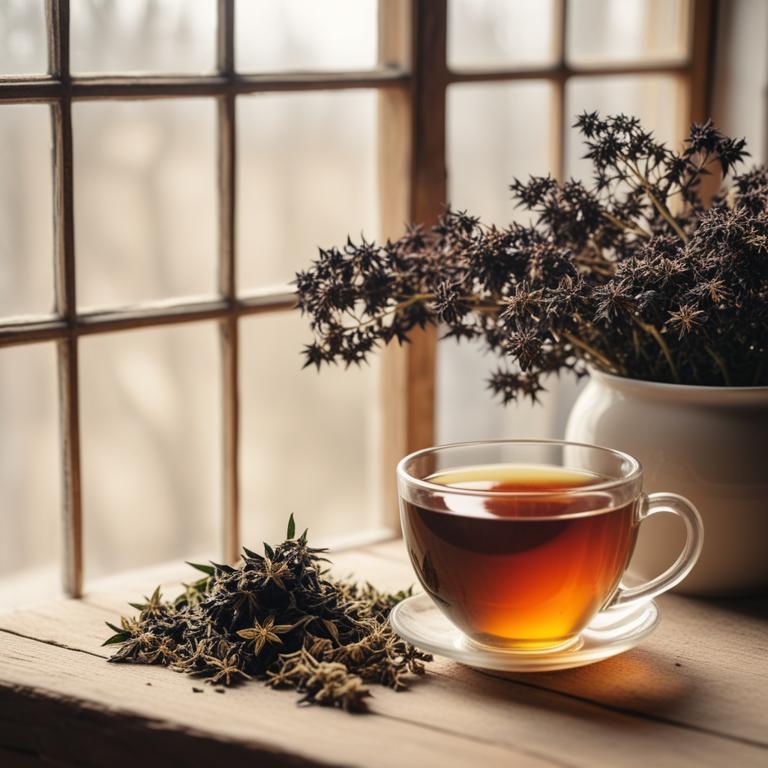
Sambucus nigra teas, also known as elderflower tea, have been traditionally used to treat dry throat ailments due to their soothing and anti-inflammatory properties.
The bioactive constituents present in this herbal preparation, such as flavonoids, phenolic acids, and sambunigrin, help to reduce throat irritation and inflammation, making it easier to swallow and speak.
The anti-inflammatory properties of Sambucus nigra teas, particularly the flavonoids and phenolic acids, help to calm the throat and reduce discomfort associated with dry throat ailments.
Regular consumption of Sambucus nigra teas has been found to provide relief from dry throat symptoms, making it a popular natural remedy for this common ailment.
Related Study
According to the Journal of alternative and complementary medicine (New York, N.Y.), Sambucus nigra teas, which are a component of Throat Coat, significantly reduced the intensity of throat pain when swallowing and provided a rapid, temporary relief of sore throat pain in patients with pharyngitis.
Recipe:
- Gather 1 cup of fresh or dried Sambucus nigra flowers and leaves.
- Combine 1 cup of the flowers and leaves with 1 cup of boiling water in a saucepan.
- Let the mixture steep for 5-7 minutes to allow the flavors to release.
- Strain the tea into a cup using a fine-mesh sieve or cheesecloth.
- Drink 1 cup of the tea warm or at room temperature to soothe a dry throat.
Sambucus nigra teas can be effective in treating dry throat ailments, but it may also cause side effects such as allergic reactions, nausea, and stomach upset in some individuals, particularly when consumed in high doses or for extended periods.
To use Sambucus nigra teas safely, it is recommended to start with small amounts, avoid taking it with other medications, and be cautious when consuming it with other herbs that may interact with its active compounds.
Sambucus Nigra Tea on Amazon
Elderberry Turmeric Ginger Tea - Made in USA
Disclaimer: We earn a commission if you click this link and make a purchase at no additional cost to you.
9. Mentha x piperita teas
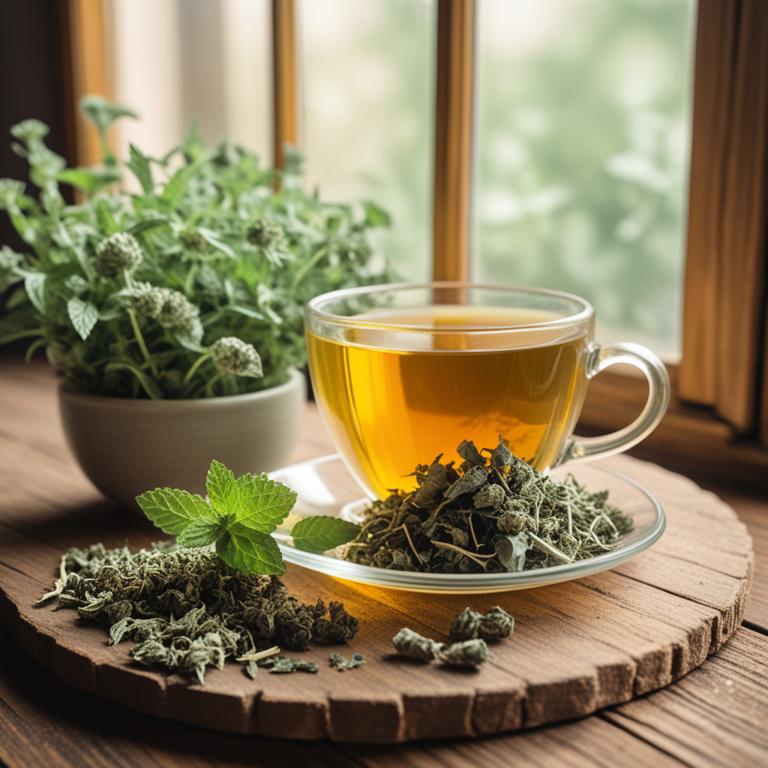
Mentha x piperita teas, also known as peppermint tea, have been used for centuries to treat dry throat ailments due to their soothing and anti-inflammatory properties.
The herbal preparation helps to treat dry throat by reducing inflammation and providing relief from pain and discomfort, allowing individuals to breathe and swallow more comfortably.
The bioactive constituents of peppermint tea, including menthol and menthone, help to treat dry throat by thinning mucus and reducing congestion, making it easier to clear the airways.
The benefits of peppermint tea in treating dry throat include its ability to provide fast and effective relief, promote relaxation, and help to reduce the risk of further irritation and infection.
Related Study
According to "Phytotherapy research : PTR", Mentha x piperita teas for dry throat have been traditionally used and recognized for their anti-inflammatory properties, which can help soothe and calm irritated mucosa.
Recipe:
- Gather 1 cup of fresh mint leaves (Mentha x piperita) and 1 cup of boiling water.
- Add 2 tablespoons of fresh mint leaves to a heat-resistant cup or teapot.
- Pour 1 cup of boiling water over the mint leaves and let it steep for 5-7 minutes.
- Strain the tea into another cup and discard the mint leaves.
- Drink the tea warm or at room temperature as needed to soothe a dry throat.
Mentha x piperita teas can help alleviate dry throat symptoms, but possible side effects include digestive issues, such as upset stomach or diarrhea, and allergic reactions like skin irritation or hives in rare cases.
To use Mentha x piperita teas safely, individuals should be cautious when consuming it in large quantities, especially for extended periods, as it may cause an imbalance of certain minerals in the body, particularly potassium.
10. Melissa officinalis teas

Melissa officinalis teas, also known as lemon balm tea, have been traditionally used to treat dry throat ailments due to its soothing and calming properties.
The anti-inflammatory and antiseptic properties of Melissa officinalis help to reduce inflammation and prevent infection in the throat, providing relief from discomfort and pain.
The bioactive constituents, including rosmarinic acid and terpenes, in Melissa officinalis tea help to relax the throat muscles and reduce spasms, making it easier to swallow and breathe.
Regular consumption of Melissa officinalis tea has been shown to provide long-term benefits in treating dry throat ailments, including reduced inflammation, improved respiratory function, and enhanced overall well-being.
Related Study
According to "Journal of alternative and complementary medicine (New York, N.Y.)", Melissa officinalis teas, such as those found in Throat Coat, provide a rapid and temporary relief of sore throat pain in patients with pharyngitis, reducing the intensity of throat pain when swallowing and improving overall pain relief.
Recipe:
- Gather 1 cup of fresh Melissa officinalis leaves or 1 tablespoon of dried leaves.
- Heat 1 cup of boiling water in a pot.
- Add the Melissa officinalis leaves to the boiling water and let it steep for 5-7 minutes.
- Strain the tea into a cup and discard the leaves.
- Drink the tea warm or at room temperature to soothe a dry throat.
Melissa officinalis teas can be effective in soothing a dry throat, but it may cause side effects such as stomach upset, nausea, and allergic reactions in some individuals, especially when consumed in large quantities or for extended periods.
To use Melissa officinalis teas safely, it is recommended to start with a low dose, monitor your body's response, and avoid drinking it before bedtime to minimize potential disruptions to sleep patterns.
Melissa Officinalis Tea on Amazon
Maxx Herb Lemon Balm Extract - Max Strength Liquid Tincture Absorbs Better Than Capsules or Tea, for Nervous System Support, & Stress Management - Alcohol Free - 4 Oz Bottle (60 Servings)
Disclaimer: We earn a commission if you click this link and make a purchase at no additional cost to you.
11. Hydrastis canadensis teas
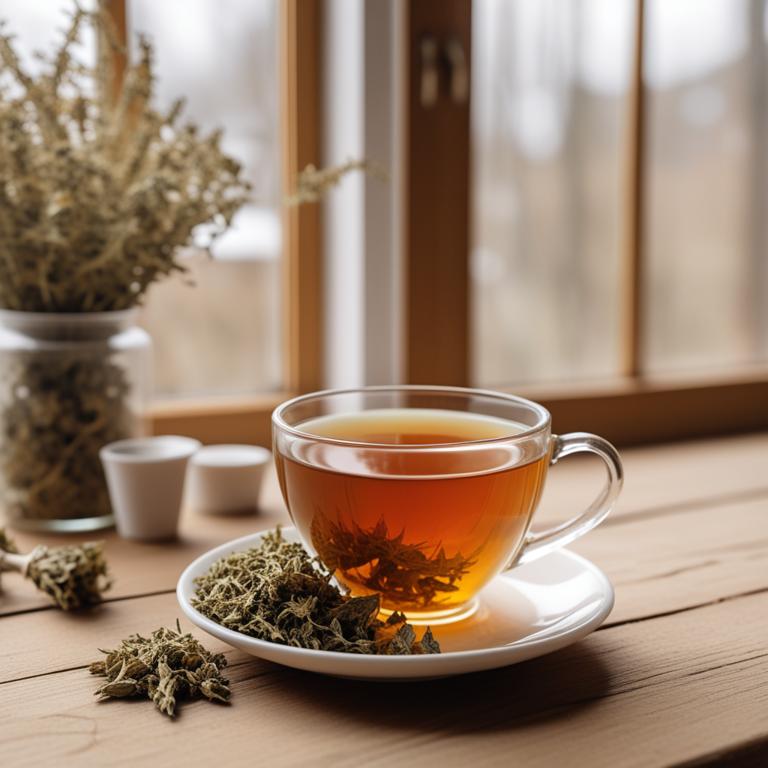
Hydrastis canadensis teas, also known as goldenseal, have been traditionally used to treat dry throat ailments due to their soothing and anti-inflammatory properties.
The bioactive constituents of goldenseal, including berberine and hydrastine, help to reduce inflammation and combat infections that can cause a dry throat.
By reducing swelling and killing bacteria, goldenseal teas can provide quick relief from dry throat discomfort and promote a healthy environment for the throat to heal.
Regular consumption of goldenseal teas can also help to boost the immune system and prevent future dry throat episodes, making it a beneficial herbal preparation for maintaining throat health.
Related Study
According to "Journal of alternative and complementary medicine (New York, N.Y.)", Hydrastis canadensis teas, as part of the Throat Coat formula, have been found to provide a rapid, temporary relief of sore throat pain in patients with pharyngitis by significantly reducing the intensity of throat pain and improving total pain relief.
Recipe:
- Gather 1 teaspoon of dried Hydrastis canadensis root.
- Use a tea infuser or a small piece of cheesecloth to hold the root.
- Place the tea infuser or cheesecloth in a cup and add 8 ounces of boiling water.
- Let the mixture steep for 5-7 minutes, then strain the liquid.
- Drink the tea 2-3 times a day as needed to soothe a dry throat.
Hydrastis canadensis teas can help alleviate dry throat symptoms when used appropriately, but possible side effects may include allergic reactions, such as hives or itching, especially in individuals with sensitive skin.
To use Hydrastis canadensis teas safely, it is essential to start with a small dose and gradually increase as needed, and to be aware of potential interactions with other medications, particularly those for diabetes and blood pressure.
12. Salvia officinalis teas
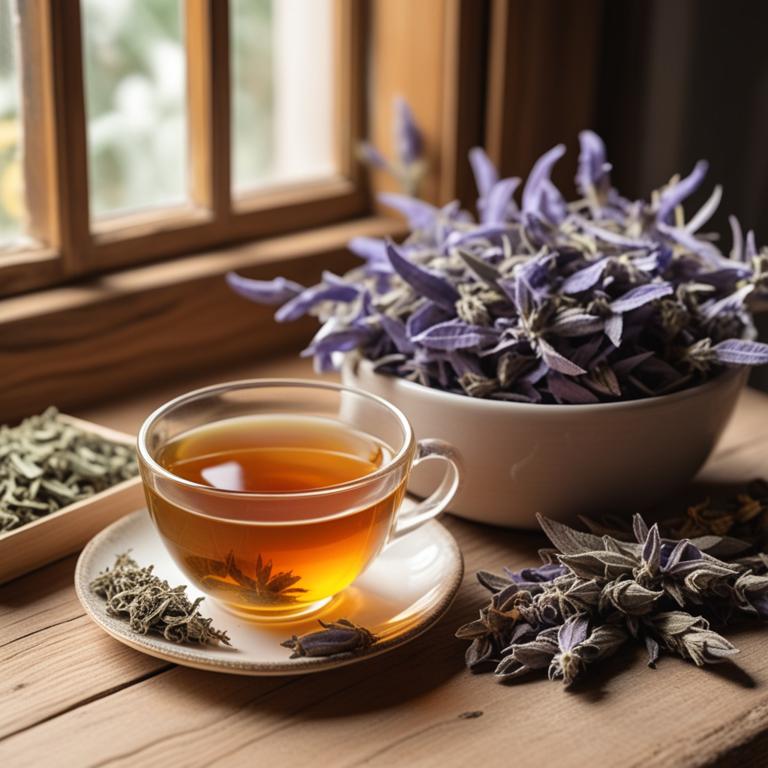
Salvia officinalis teas have been traditionally used to treat dry throat ailments due to their soothing and anti-inflammatory properties.
This herbal preparation helps to treat dry throat by providing relief from irritation and inflammation, allowing for smoother breathing and swallowing.
The bioactive constituents of Salvia officinalis, including flavonoids and phenolic acids, contribute to its therapeutic effects by reducing oxidative stress and promoting mucosal healing.
Regular consumption of Salvia officinalis teas has been shown to provide benefits such as reduced symptoms of dry throat, improved throat comfort, and enhanced overall respiratory health.
Related Study
According to "European journal of medical research", Salvia officinalis teas for dry throat may be effective in providing symptomatic relief within the first two hours after administration, as a 15% sage spray was found to be significantly superior to placebo in reducing throat pain intensity score.
Recipe:
- Gather 1 cup of fresh Salvia officinalis leaves or 1 tablespoon of dried leaves.
- Place the leaves in a heat-resistant cup.
- Pour 1 cup of boiling water over the leaves.
- Let the mixture steep for 5-7 minutes, then strain the leaves.
- Drink the tea as needed to soothe your dry throat.
Salvia officinalis teas can be used to treat dry throat, but possible side effects may include stomach upset, allergic reactions, or interactions with other medications due to its high thymol content.
To use Salvia officinalis teas safely, take precautions such as using small amounts, drinking plenty of water, and avoiding consumption if you have sensitive stomachs or allergies to ensure effective relief from dry throat without adverse effects.
Salvia Officinalis Tea on Amazon
Organic India Tulsi Sweet Rose Herbal Tea - Holy Basil Leaf, African Basil, Chamomilie, Lemon Myrtle, Stress Relieving, Immune Support, USDA Certified Organic, Caffeine-Free - 18 Infusion Bags, 6 Pack
Disclaimer: We earn a commission if you click this link and make a purchase at no additional cost to you.
13. Achillea millefolium teas
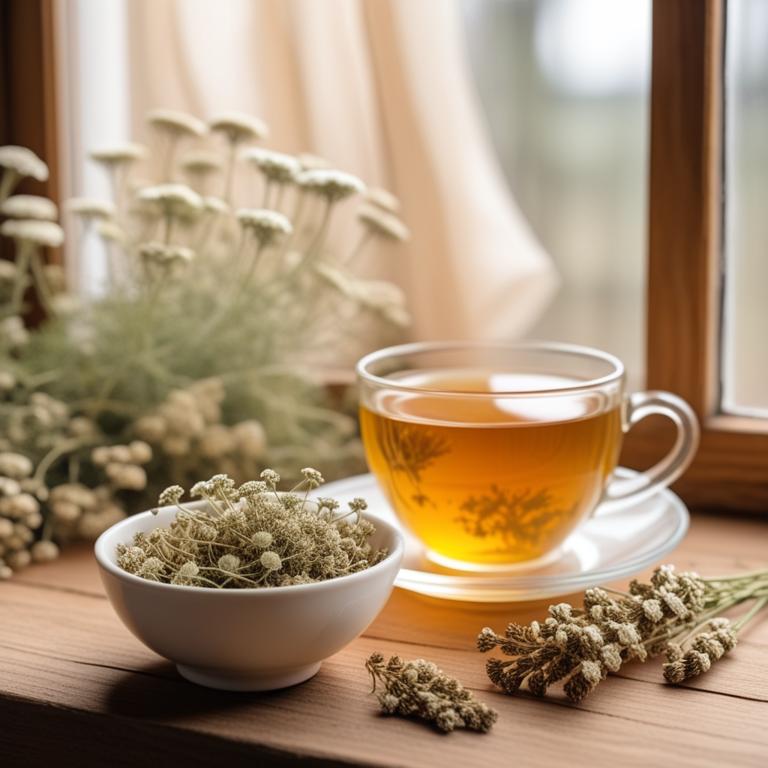
Achillea millefolium teas have been used to treat dry throat ailment due to their soothing and anti-inflammatory properties.
The herbal preparation helps to treat this ailment by providing relief from irritation and discomfort in the throat, reducing inflammation and promoting healing.
The bioactive constituents of Achillea millefolium teas, including flavonoids, phenolic acids, and sesquiterpene lactones, contribute to its therapeutic effects by exhibiting antioxidant and anti-inflammatory activities.
The benefits of using Achillea millefolium teas to treat dry throat ailment include reduced throat irritation, improved throat health, and a soothing effect that promotes relaxation.
Related Study
According to "Journal of alternative and complementary medicine (New York, N.Y.)", Achillea millefolium teas, which are a key ingredient in the Throat Coat herbal tea, provided a rapid, temporary relief of sore throat pain, and significantly reduced the intensity of throat pain when swallowing in patients with pharyngitis.
Recipe:
- Gather 2 cups of fresh Achillea millefolium leaves or 1 cup of dried leaves.
- Place the leaves in a saucepan and add 2 cups of water.
- Bring the mixture to a boil, then reduce heat and let simmer for 5-7 minutes.
- Strain the tea into a cup using a fine-mesh sieve or cheesecloth.
- Drink the tea warm or at room temperature, 2-3 times a day, to soothe a dry throat.
Achillea millefolium teas can be used to treat dry throat ailment, but potential side effects may include allergic reactions, interactions with other medications, and an increased risk of bleeding, especially when taken in large quantities.
To use Achillea millefolium teas safely, one should start with small doses, monitor their body's response, avoid taking it with blood-thinning medications, and be cautious of potential interactions with other herbal preparations.
Achillea Millefolium Tea on Amazon
Biokoma Pure and Organic Yarrow Dried Herb 30 Tea Bags 1.5oz In Resealable Moisture Proof Pouch, USDA Certified Organic - Herbal Tea, No Additives, No Preservatives, No GMO, Kosher
Disclaimer: We earn a commission if you click this link and make a purchase at no additional cost to you.